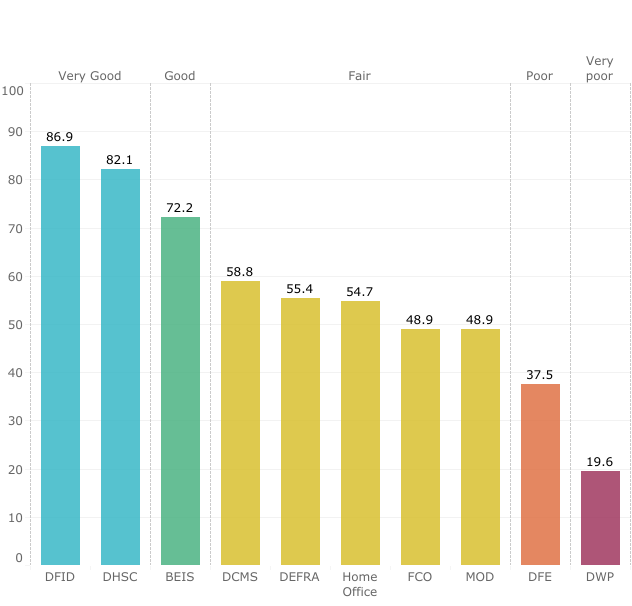3 Out of 10 UK Government Departments Meeting 2020 Targets for Aid Transparency
New review finds:
- More aid data is being published by government departments, but there is still a critical lack of information on the impact and performance of aid projects
- If transparency is valued and institutionalised, significant improvements can be made by all aid-spending departments
- The government should re-commit to aid transparency targets, to encourage continued improvement
Only three out of ten government departments have reached the level of transparency set out in its 2015 UK Aid Strategy. A detailed review released today by Publish What You Fund assessed ten government departments spending significant amounts of official development assistance (ODA) and found that they all now share some data on their aid and many have improved the regularity and quantity of information they make available through the International Aid Transparency Initiative (IATI). However, currently only the Department for International Development (DFID), the Department of Health and Social Care and the Department for Business, Energy and Industrial Strategy meet the aid transparency targets the government is due to meet by 2020.
Gary Forster, CEO of Publish What You Fund, said:
“Sharing transparent aid data allows both aid recipients and taxpayers to scrutinise how aid is being spent and assess if it is being delivered effectively and providing value for money. Transparency also facilitates cross-government learning to drive improvements in aid and development programming. Our assessment shows that seven government departments still have much work to do in order to be open and accountable for their aid spending. But we also found much to be hopeful about.”
“Our findings illustrate what is possible when departments institutionalise transparency, invest time and effort into adapting systems and processes, and change the organisational culture to value and promote transparency. We’ve seen significant ODA spending departments achieve high transparency scores despite only relatively recently being subject to scrutiny.”
The 2015 aid strategy set a target for all government departments to be ranked as “Good” or “Very Good” in the Aid Transparency Index within five years. The UK government asked Publish What You Fund, the global campaign for aid and development transparency, to assess ten aid-spending departments using its Aid Transparency Index methodology. Publish What You Fund also reviewed the transparency of the Conflict, Stability and Security Fund and Prosperity Fund, assessing the progress they have made in publishing data to the IATI registry and making information available through government websites, and making a number of recommendations for improvement.
The Foreign and Commonwealth Office improved on its “Poor” ranking from the 2018 Aid Transparency Index, moving into the “Fair” category. However, it has not yet achieved the government’s target. DFID maintained its “Very Good” ranking which it scored in 2018.
Alex Tilley, author of the review, “How Transparent is UK Aid? A review of ODA spending departments” commented:
“The weakest area for all departments was transparency on the impact and performance of aid projects. This kind of information is vital for learning and continual improvement of the efficacy of aid programmes. It is essential if UK Aid is to maintain its world class reputation and ultimately if we want to make the greatest contribution to alleviating poverty and hitting the Sustainable Development Goals. We urge all departments to share more evaluations and results of their aid spending.”
“We need to build on the momentum for improved transparency. The current aid strategy runs to the end of 2020. It is vital that the UK’s next aid strategy maintains the commitment to transparency, with measurable targets.”


